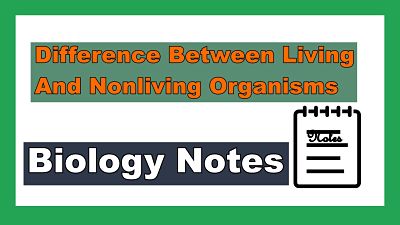Everyone easily understands the difference between living and nonliving organisms. But to define life is a difficult task.
We describe the unique personnel that organisms develop, such as movement or locomotion, digestion, respiration, excretion, response to stimuli and adaptation to changing circumstances.
Some internal processes that are not perceived externally include metabolic reactions, action of enzymes and hormones, immune system function and more.
These phenomena are similar in many organisms and different in others. Taken together, they can define life as a condition that separates animals, plants, and microorganisms from biological and non-organic organisms and nonliving organisms, as expressed by the above works. The organism undergoes constant change, until death.

Characteristics Of Organisms That Difference Between Living And NonLiving Organisms
Some important characteristics of organisms that differentiate between living and nonliving organisms are discussed below.
1. Metabolism
They contain varying amounts of minerals and organic molecules in the cells of organisms that make up the intracellular environment. They participate in thousands of different biochemical reactions to perform various functions necessary for the survival of organisms.
These reactions are complete metabolism, which is further divided into catabolism (destruction process) and anabolism (formation process), such as the formation of protein molecules and the breakdown of glucose molecules in cellular respiration.
Many metabolic processes are similar to microorganisms, plants, and animals, while some other processes are specialized in certain groups of organisms.
A metabolic reaction can be demonstrated in the laboratory (in vitro status). Inanimate substances do not perform such metabolic processes.
2.Physiological Processes
Based on the number of cells in the body, we divide organisms into unicellular (single cell) and multicellular (multi cell) types. Although all cellular processes are performed within a cell, cells or groups of tissues or organs perform different functions in many cellular organisms.
On the other hand, animals and plants differ from each other, that is, nutrients from drinking water and soil and photosynthesis that occur in plants, but not in animals. However, the basic design of physiological processes in different groups of organisms is very similar.
3. Growth
Organisms have distinct characteristics of development up to a certain age. But in plants, the body (mass) grows throughout life. Therefore, body weight gain is considered as the growth of organisms.
In single cells, it only increases through the mass of single-cell bodies, whereas in multicellular organisms the mass and number of body cells increase.
Growing organisms reach adulthood when they reproduce their species. Organisms repair their damaged areas or regenerate lost areas by creating new cells according to some cell division.
Although dead organisms do not grow, some objects, such as mountains and sand dunes, grow in size by placing objects on their surface through some geophysical processes.
In contrast, organisms develop from within. In considering this, we can say that evolution is a feature of living things.
4. Reproduction and Continuation of Race
Organisms continuously breed throughout their lives and the parents’ characters are given to their children in this process. Originally, there are two types of reproduction: lesbian and sexual. Only one parent is involved in abnormal reproduction;
During sexual reproduction: Both male and female parents are involved. Most single-celled and some low-biodiversity organisms breed across multiple sexes.
Bacteria, unicellular algae, and amoebae divide by division, while fungi are produced by a large number of spores.
Yeast and Hydra produce offspring by germination. Fiber algae, many fungi, protonema of algae, plenaria multiply in their numbers.
In higher plants and animals, the most common method of reproduction of the offspring is the sexual reproductive system, in which cells or gametes (sperm and eggs) join to form a zygote, which delivers the offspring of its kind at the right time. However, some organisms cannot reproduce sexually due to inactivity.
5. Response to Stimuli
Another important feature of living organisms, from prokaryotes to superior eukaryotes, is their ability to perceive changes in their environments.
They respond to a variety of physical, chemical, and biological stimuli derived from their environment to ensure survival.
All organisms are affected by external stimuli such as light, temperature, water, and pollutants. However, apart from all these factors, animals are affected by other organisms around them.
Organisms have the ability to control the chemicals that enter their bodies. Seasonal breeding plants and animals are affected by photosynthesis (day length).
A lifestyle is more complex than a sophisticated supercomputer. Although molecules are individuals who cannot create life, their unified relationship makes life possible.
A group of cells or tissue may perform a function that the cell cannot; A tissue cannot perform a function that an organ can perform.
All groups, organs, and organ systems interact with each other as a superior organism. The ascending order of groups of organisms is Organ Element in Organ Element and Organ-System Quality.
All organisms are self-replicating, self-regulating and developing systems capable of responding to environmental responses.
Biology is the study of organisms as a discipline, including microbiology (the study of microorganisms), botany (the study of plants) and zoology (the study of animals).

